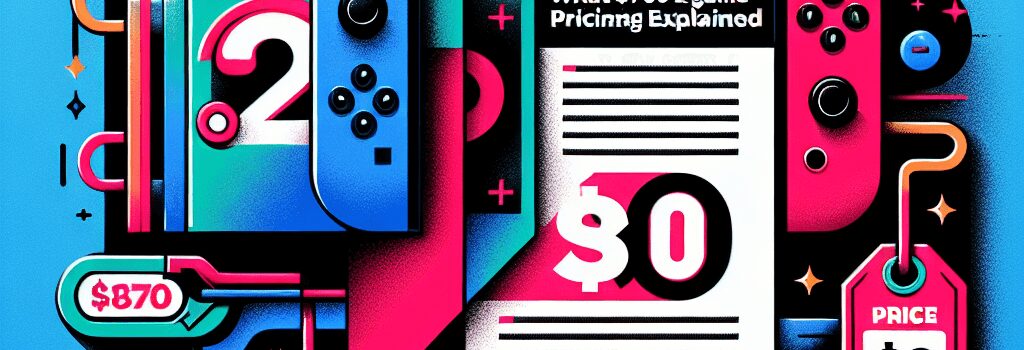Switch 2 Game Pricing Explained: What $70 and $80 Tags Mean for the Future

Nintendo’s recent presentation for the Switch 2 detailed not only the console’s starting price of $449, but also a range of accessory prices—from an $80 Pro Controller to a $110 replacement dock. However, one aspect that wasn’t explicitly covered was game pricing. Early first-party titles such as Mario Kart World and Donkey Kong Bananza are already hinting at a shift towards a premium price point for Switch 2 games.
Early Price Signals and What They Mean
For instance, Mario Kart World is priced at $80 when purchased separately, a significant jump from the typical $60 first-party game price on the current Switch. When bundled as part of a Switch 2 package, the digital copy drops to $50, effectively encouraging consumers to opt for the upgrade. In contrast, Donkey Kong Bananza, scheduled for a release around July 17, carries an MSRP of $69.99. This placement aligns more closely with the $70 standard seen on current-gen consoles from Sony and Microsoft.
The pricing disparity between titles could reflect several factors including differing production costs, enhanced online multiplayer features, or a broader strategy to push specific bundle options. Experts speculate that the more network-intensive experiences, which include advanced online functionalities, may require additional server infrastructure and development resources that justify a higher price tag.
Technical Analysis of Modern Game Pricing
From a technical standpoint, modern game development demands the use of state-of-the-art hardware and extensive software optimization. The Switch 2 is expected to showcase improved graphical capabilities and advanced processing power, which means that developers are leveraging more robust engines, increased asset resolutions, and more sophisticated AI behaviors. These enhancements require additional man-hours and higher quality control processes, which in turn drive up manufacturing and development costs.
- Graphics and Processing: The improved hardware on the Switch 2 can handle richer textures and more complex animations, allowing for an immersive gaming experience but also leading to increased resource consumption during development.
- Online Infrastructure: Games like Mario Kart World come with more sophisticated online components, necessitating a stronger digital infrastructure and a potential rethinking of recurring service fees.
- Development Tools: Enhanced development toolkits and middleware that support high-definition graphics and physics simulations demand higher initial investments that are often recouped through game pricing.
Economic and Consumer Implications
While inflation is one component that could explain a shift from a $60 to a $70 or $80 price range, many analysts believe that the improvements in game quality and production complexity play a major role. For example, using the overall inflation rate as a benchmark, a $60 game in 2017 could cost approximately $78 today. However, the gaming industry has seen accelerated cost increases in certain areas, especially in online infrastructure and advanced hardware support, which may result in prices slightly exceeding inflation adjustments.
This price adjustment, when viewed through the lens of consumer behavior, might also serve as a strategic lever. Nintendo appears to be using the difference in standalone and bundled pricing as a way to entice consumers toward the Switch 2 bundle, helping ensure a smooth transition between console generations. Additionally, the planned upgrade paths for Switch 2 Edition games are expected to include a price difference of $10 to $20, providing a pricing model reminiscent of upgrade fees seen in other systems like Sony’s transition from PS4 to PS5.
Expert Opinions and Future Trends
Industry experts have pointed out that the current pricing strategy might be part of a larger trend towards tiered offerings in the console market. Nintendo is reportedly exploring various models, including offering certain additional benefits to subscribers of its higher-tier Nintendo Switch Online service. For instance, upgrade packs for iconic franchises such as Breath of the Wild and Tears of the Kingdom are scheduled to be complimentary for Nintendo Switch Online + Expansion Pack subscribers.
Technical analysts argue that as games continue to evolve in terms of graphics and integrated online services, a modular pricing strategy could become the norm. The possibility of offering distinct versions—optimized for either the original Switch or the upgraded Switch 2—mirrors Sony’s strategy, where a modest upgrade fee grants access to enhanced editions. Such trends are likely to push both development budgets and consumer expectations higher.
Looking Ahead: Console Upgrades and Consumer Strategy
The real question for consumers and industry watchers alike is the eventual cost of Switch 2 Edition game upgrades for multi-platform titles like Metroid Prime 4 or Pokémon Legends: Z-A. Although the current data suggests an upgrade fee of roughly $10 to $20, the eventual pricing will be influenced by various factors including production costs, market competition, and consumer demand for higher fidelity gaming experiences.
With the console market already feeling the impact of inflationary pressures and a heightened emphasis on quality and service, Nintendo’s careful pricing approach aims to balance cost recovery with maintaining consumer satisfaction. Whether these initial pricing signals will set a long-term standard for first-party titles on the Switch 2 remains a point of discussion among both hardware experts and economic analysts.
As the Switch 2 ecosystem continues to evolve, keeping an eye on these pricing trends could provide valuable insights for developers, investors, and gamers alike as they navigate the next wave of console advancements.